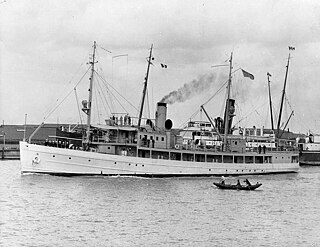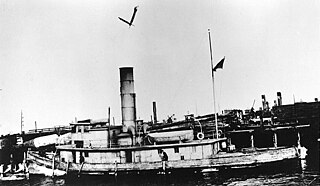
A minesweeper is a small warship designed to remove or detonate naval mines. Using various mechanisms intended to counter the threat posed by naval mines, minesweepers keep waterways clear for safe shipping.

USS Penguin (AM-33) was a Lapwing-class minesweeper acquired by the United States Navy, named after the bird.

USS Lapwing (AM-1/AVP-1) was the lead ship of her class of minesweeper – the first minesweeper of the United States Navy. She was named after a bird, the lapwing, an abundant crested plover of Europe, Asia, and northern Africa, noted for its slow, irregular, flapping flight and its shrill wailing cry.

USS Turkey (AM-13) was an Lapwing-class minesweeper acquired by the U.S. Navy for the dangerous task of removing mines from minefields laid in the water to prevent ships from passing.

USS Pelican (AM-27/AVP-6) was an Lapwing-class minesweeper acquired by the United States Navy for the dangerous task of removing mines from minefields laid in the water to prevent ships from passing.

The first USS Swan (AM-34/AVP-7) was a Lapwing-class minesweeper acquired by the United States Navy.
USS Limpkin (AMc-48) was an Accentor-class coastal minesweeper acquired by the United States Navy for clearing coastal minefields. The vessel was launched on 5 April 1941 and entered service on 8 August. Limpkin operated off New York City and the mouth of Chesapeake Bay during World War II. Following the war, the minesweeper was taken out of service on 15 April 1946 and sold to private interests and converted to a commercial trawler. The ship was renamed Hiawatha and then Blue Waters.
USS Gypsum Queen (SP-430) was a tugboat acquired by the United States Navy during World War I. She was assigned to the French coast as a minesweeper, as well as a tugboat to provide assistance to disabled Allied ships. Performing this dangerous work, Gypsum Queen struck a rock near Brest, France, and sunk, sending 15 crew members to their deaths.

The second USS Pocomoke (SP-265), later YT-43, was a United States Navy minesweeper and tug commissioned in 1917 and sold in 1922.
The second USS Newark (SP-266) was a United States Navy minesweeper and tug in commission from 1917 to 1919.
USS Lowell (SP-504) was a United States Navy patrol vessel and minesweeper in commission from 1917 to 1919.
USS George P. Squires (SP-303) was United States Navy patrol vessel and minesweeper in commission from 1917 to 1918.
USS Freehold (SP-347) was a minesweeper and tug that served in the United States Navy from 1917 to 1919.

The first USS Roselle (SP-350) was a minesweeper that served in the United States Navy during 1917. Roselle was built as a commercial steam harbor tug of the same name in 1903 by Neafie and Levy at Philadelphia. On 10 May 1917, the U.S. Navy acquired her from her owners, the Central Railroad Company of New Jersey, for use as a minesweeper during World War I. She was commissioned on 22 September 1917 as USS Roselle (SP-350). Assigned to the 3rd Naval District, Roselle was based at Tompkinsville, Staten Island, New York. She conducted minesweeping patrols in Long Island Sound.

USS Charles P. Crawford (SP-366) was a United States Navy minesweeper and tug in commission from 1917 to 1919.
USS Elizabeth M. Froelich (SP-380) was a minesweeper that served in the United States Navy from 1917 to 1919.

USS Knickerbocker (SP-479), was a United States Navy tug, minesweeper, and dispatch ship in commission from 1917 to 1919.

USS Tasco (SP-502), was a United States Navy minesweeper and patrol vessel in commission from 1917 to 1919.

USS Pennsylvania R. R. No. 9 (SP-679), also known as USS Penn R. R. No. 9 (SP-679) and USS P.R.R. No. 9 (SP-679), was a United States Navy armed tug and minesweeper in commission from 1917 to 1919.

USS Satilla (SP-687) was a United States Navy patrol vessel in commission from 1917 to 1919.













